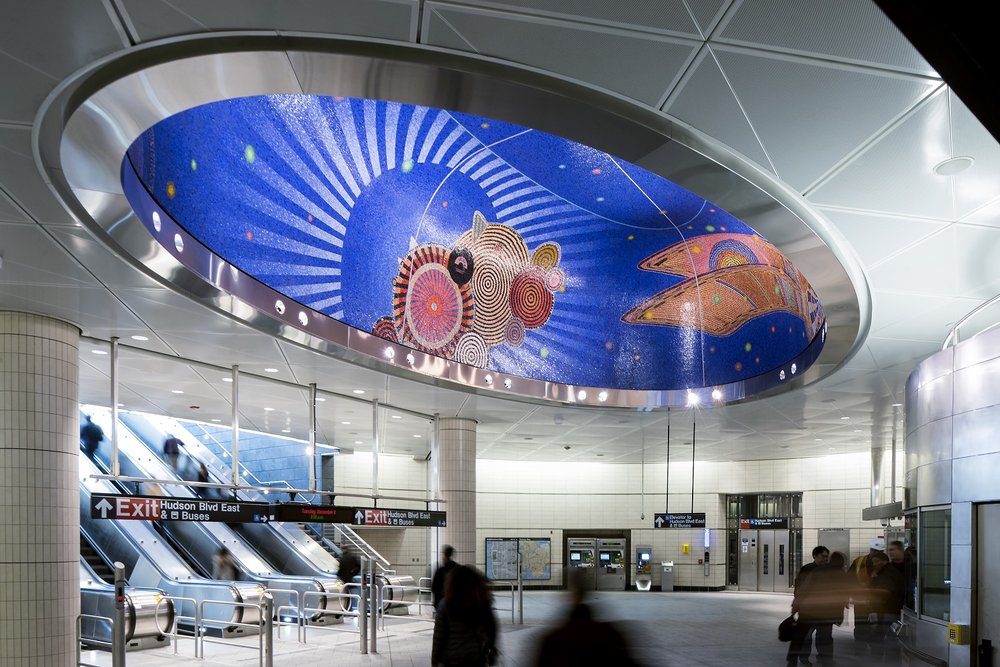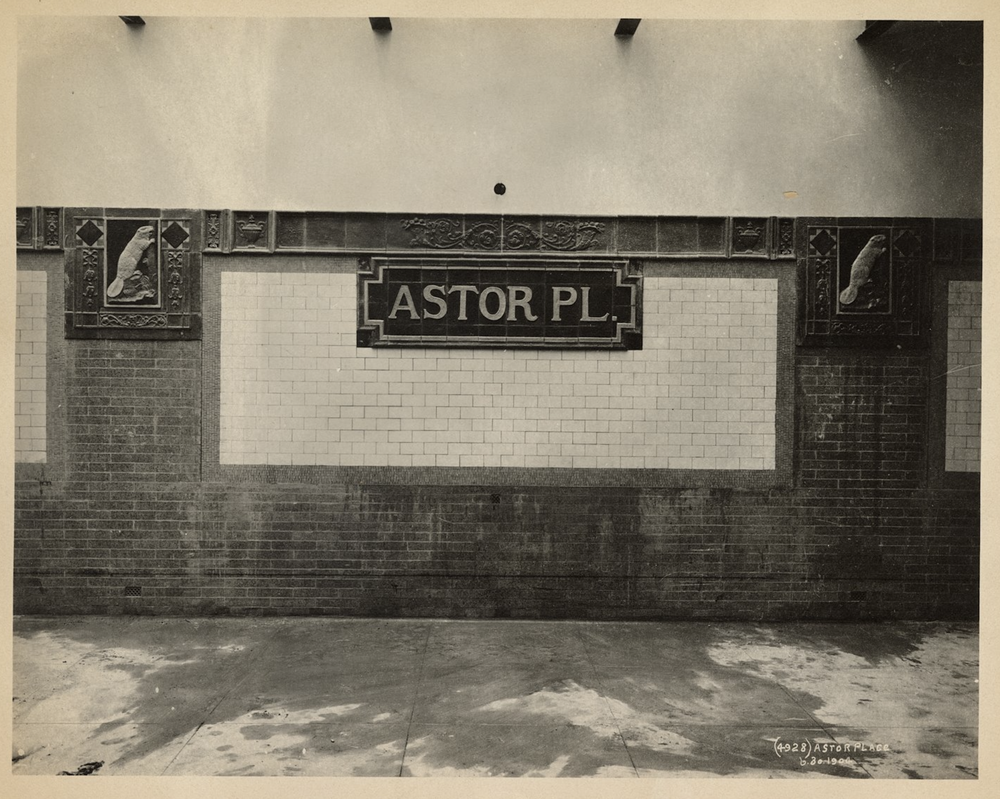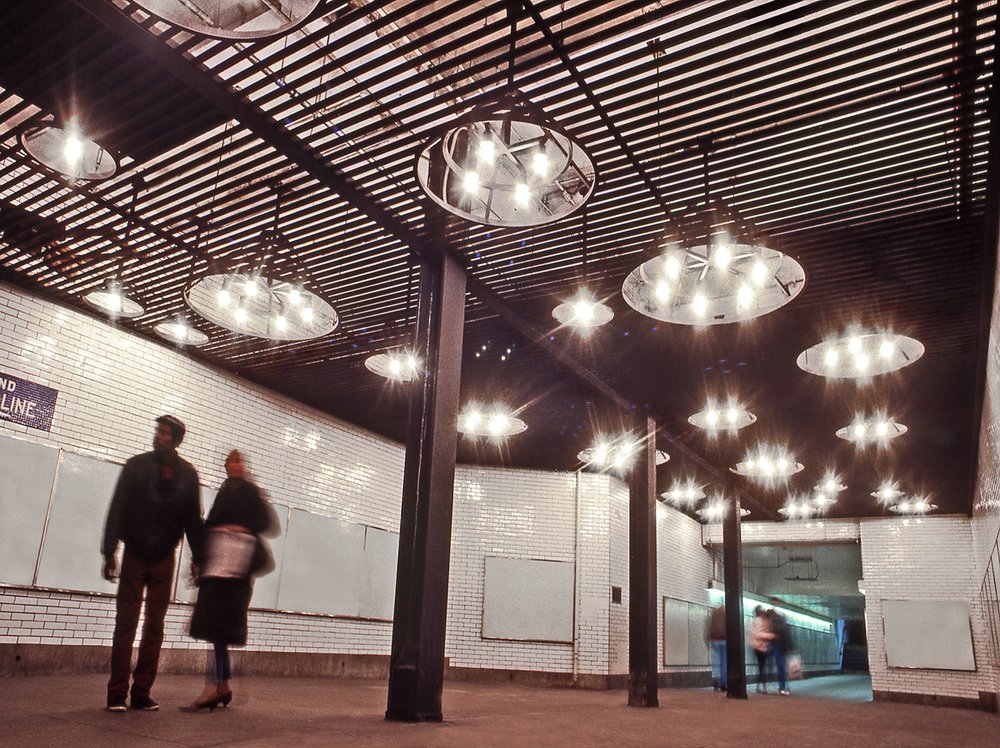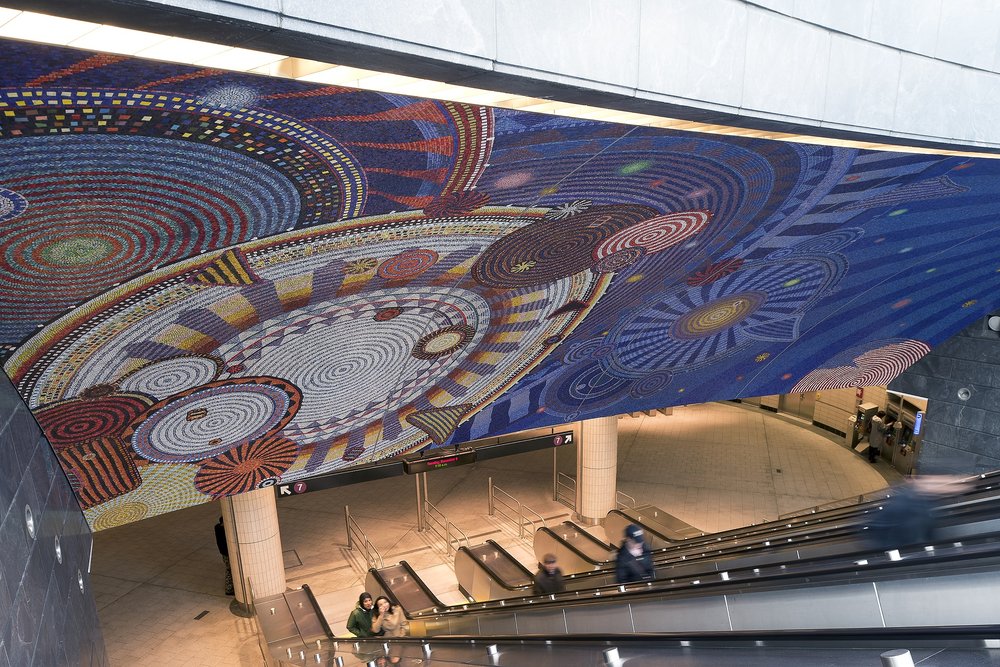Bringing the cosmos underground: celebrating public art created by women for the NYC subway
March 30, 2023, 6:01 a.m.
A virtual tour highlights a selection of subway art by women, from Yoko Ono’s sky paintings at 72nd Street to Faith Ringgold’s ode to Harlem at 125th Street.

When Jean Shin was selected by the MTA to create artwork for the 63rd Street station, which was one of the first to open along the long-awaited Second Avenue Subway in 2017, she found herself inspired by the drawn-out history of the line.
“It was a subway that was promised to New York City over 100 years ago and just never arrived,” Shin said. “I feel like it's a beautiful story of what people dream of, and of course infrastructural failure, until generations later we get the new subway.”
Shin’s piece, “Elevated,” is one of the artworks being discussed this Thursday evening in “Women Artists in the Subway,” presented by the New York Transit Museum. The event, a virtual tour, will highlight a selection of subway art by women, from Yoko Ono’s sky paintings at 72nd Street to Faith Ringgold’s ode to Harlem at 125th Street.
Shin worked on her project for seven years in total. Using a mix of ceramic tile, glass mosaic and laminated glass, she recomposed archival black-and-white photographs from the 1940s, which documented the dismantling of the elevated trains on Second Avenue.
“I could just imagine a New Yorker saying, ‘Oh my God, they're taking away the elevated. Now we're going to definitely get the Second Avenue!’” Shin said. “But then it never happened. And I wanted to see these New Yorkers being honored. They never got to see the subway. Now they're in it.”

Art historian Amy Raffel, public programs manager at the Transit Museum, says about 130 out of the 260 pieces of artwork currently in the subway system were made by women. “I could have a 10-hour talk on just the women in the subway,” she said, “and that's not to mention all the other amazing artworks as well.”
The integration of art in the subway
Subways have incorporated artwork since the Interborough Rapid Transit Co. opened the first line in 1904. The earliest stations utilized colored tiles, vaulted ceilings, chandeliers and high-relief terracotta embellishments that reflected the locations. And it wasn’t just because of aesthetics.
”Not all New Yorkers were necessarily literate, so the idea was to help show people how to get off at a stop,” Raffel said. “It might show a ferry to represent the South Street Seaport, or beavers at Astor Place, because [John Jacob Astor] basically made his fortune in the beaver pelt trade.”

Raffel says that after World War II, public funds were diverted from urban infrastructure projects as people left the cities for the suburbs. By the 1970s, the city was on the brink of bankruptcy, and the most prevalent form of artwork on the subways was graffiti. But with an influx of capital in the 1980s, officials wanted to start projects to beautify the system and promote transit use again.
Since 1982, the city’s Department of Cultural Affairs has mandated that 1% of the budget for city-funded construction projects must be spent on public artwork. MTA Arts and Design was created in 1985 to fulfill that promise. Ever since, a panel of experts has selected artists, ensuring they reflect the demographics of an ever-growing city.
“When they're looking at a given location, they're thinking about the neighborhood,” said Raffel. “New York has been extremely diverse since the ‘80s. It naturally makes sense that certain individuals are nominated or their proposals are selected because they respond to that neighborhood, which lends itself to a diversity of voices.”
The first sanctioned work of art by a female artist was Nancy Holt’s “Astral Grating,” put up in a passageway in the Fulton Street station in 1987. Holt was well-known for her work with the Land Art movement, which sought to incorporate natural and site-specific elements into artwork to raise consciousness about ecological concerns.
“There's so much artwork in the system that evokes the nature of the neighborhood or location, including several that incorporate the sky,” Raffel said. “It's kind of this natural tendency, I think, to want to bring nature into underground spaces.”

Bringing the cosmos underground
One of Raffel’s favorite pieces is Nancy Blum’s "Roaming Underfoot," which was installed in 2019 at the 28th Street station near the Flower District. It’s a gorgeous series of mosaics depicting seven kinds of plants — camellias, daffodils, hellebores, hydrangeas, magnolias, redbuds and witch hazel — which are all collected by the nearby Madison Square Park Conservancy.
Blum says having her art displayed in a public space was enticing: “It's clear it's the pinnacle of one's career when one gets to do a commission like this in the subway, where so many people get to enjoy your artwork.”
It was sweeter still to know that a diverse array of artists got the opportunity to display their work throughout the transit system.
“As a female artist, it's very discouraging to be a minority in pretty much every art situation you can find yourself in in the city,” Blum said. “To be part of a more balanced system is just as good as it gets.”

Not every artist had the advantage of working with an existing subway. Xenobia Bailey was commissioned to create her piece, “Funktional Vibrations,” at the 34th Street-Hudson Yards station several years before it was built.
Bailey works mostly in crochet and fiber art. For this piece, she drew on Atlantic Records singles, her mother’s textiles and her African heritage to create a series of vibrant geometric circles, set against a indigo blue backdrop. But she had no idea how it would fit the station.
“I was trying to imagine people in that space with the artwork, when the space didn't even exist,” Bailey said. “That was really challenging, because I wanted them to feel a connection to the cosmos.”
She transferred her textile creations to digital images, which were blown up into three huge mosaics in the station’s ceiling. It became her first public art piece, and is still her largest.
Bailey says she sometimes visits the station on her birthday to talk to onlookers and hand out buttons. Jean Shin, the artist behind the 63rd Street station, says she also sometimes rides the train a few extra stops to check in on her piece.
“There's a series of three women who are reading,” Shin said. “It looks like they're going to work or they're coming from work, and I can imagine them going off on their dates or going to their families. And the dialogue is still happening between these women many generations later.”
“Women Artists in the Subway” is happening March 30 at 6 p.m. Get more info here.
 A Brief History Of The Long-Awaited Second Avenue Subway
How a color-coding system changed NYC's subway map forever
A Brief History Of The Long-Awaited Second Avenue Subway
How a color-coding system changed NYC's subway map forever